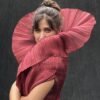Nicolas Ghesquière presented sharp tailoring and flamboyant silhouettes in Barcelona’s cultural icon.
Louis Vuitton creative director for women’s wear Nicolas Ghesquière presented his Cruise 2025 collection at Park Güell in Barcelona last week. The collection carries Ghesquière’s signature style, which Louis Vuitton describes as “characterized by a passionate Spanish flair (that cultivates) a multifaceted allure through an emotional journey of discovery.”
Cruise ’25’s palette is in sharp contrast to Gaudi’s colorful, architectural masterpiece, highlighting the fashion house’s flair for dramatic settings, such as Cruise 2024’s show at Isola Bella on Lake Maggiore. The avant-garde design of Park Güell created a captivating backdrop enhanced by James Chinlund’s harmonious curved scenography.



Gaudi’s Park Güell is a masterpiece in architectural innovation, incorporating elements of intricate mosaics, organic forms, and vibrant colors. Here’s what you need to know about this magnificent estate in Barcelona.
An eccentric design
Gaudi’s visionary design represents innovative Catalan Modernism. Spanish industrialist and Gaudi patron Eusebi Güell commissioned the architect in 1900 to design a residential estate inspired by the English garden city movement. The idea was that it would be a self-contained community of houses, public spaces, and gardens.
At the time, only two houses were constructed, and the project was abandoned in 1914. The city acquired the site in 1922 and transformed it into a public park.

The park’s entrance is marked by a pair of gatehouses that resemble gingerbread houses, setting a whimsical tone for what’s ahead. These structures show Gaudi’s penchant for integrating architecture with nature.
One of the park’s most famous features is the Dragon Stairway, which leads to the Hypostyle Hall. The stairway is flanked by fountains, and at its center sits a mosaic-covered dragon, or salamander, which has become an unofficial symbol of both the park and the city.

Originally intended as a market, the Hypostyle Hall features 86 Doric columns adorned with medallions. The term “hypostyle” comes from the ancient Greek “hupostulos,” which means “supported by columns,” and that’s exactly what they are doing to the roof.
The ceiling combines natural motifs with geometric patterns to create an interplay of light and shadow. Above the Hypostyle Hall lies the Nature Square (Plaça de la Natura), an open space offering panoramic views of Barcelona and the Mediterranean Sea.
Nature designer
Gaudi loved nature. He studied its structures such as honeycombs, tree branches, and seashells, and incorporated their shapes and principles into his projects, believing that design should be in harmony with its natural surroundings.



So he incorporated existing trees and rock formations into his architecture. The park’s viaducts, for instance, mimic the forms of natural rock outcrops. The result is both functional and aesthetic, providing shaded walkways for visitors.
Of all the gardens in the park, visitors love the Austria Gardens the most. Its name derives from the trees and plants sent from Austria for an exhibition. Its accessibility has made it a vital green space for Barcelona residents seeking relaxation and recreation in their free time.



The square’s famous serpentine bench is covered in “trencadis” or a type of mosaic made from shards of tile and broken chinaware. This bench is not only one of the park’s most famous features, Gaudi also designed it for ergonomic comfort so people can sit and relax as they explore the park further.
Park Güell has inspired countless architects, artists, and designers worldwide, who draw on Gaudi’s innovative use of materials and his integration of natural forms even after more than a century of colorful existence.




